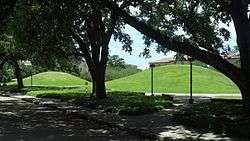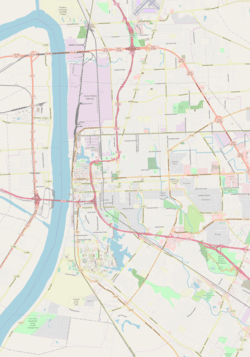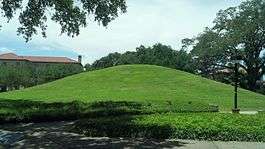LSU Campus Mounds
The LSU Campus Mounds or LSU Indian Mounds are two Native American mounds, likely of the Archaic Period, on the campus of Louisiana State University in Baton Rouge, Louisiana. The 20 feet (6.1 m) tall mounds are commonly thought to be more than 5,000 years old,[2][3] and one estimate places them at 11,300 years old. They predate the Great Pyramids of Egypt,[4] and are believed to be the oldest surviving man-made structure in the Americas,[5] or possibly the whole world.[6]
LSU Campus Mounds | |
 | |
 | |
| Location | Along Field House Drive, on Louisiana State University Campus, Baton Rouge, Louisiana |
|---|---|
| Coordinates | 30°24′54″N 91°10′56″W |
| Area | 2 acres (0.81 ha) |
| Architectural style | Earthen mounds |
| NRHP reference No. | 99000236[1] |
| Added to NRHP | March 1, 1999 |

History
The mounds were built thousands of years ago on a spot overlooking the floodplain of the Mississippi River[7] in what is now Baton Rouge, Louisiana, and the site of Louisiana State University. The northern mound consists of hard clay dirt; the southern mound is more porous.[8][9] The scholarly consensus is that they were used for "ceremonial and marking point purposes,"[8] rather than for burial.[2] They are part of a larger, statewide system of mounds.
They were first dated in 1982. In 2009, LSU professor Brooks Ellwood took core samples that revealed a layer of charcoal, possibly from a pit barbecue or a cremation.[8] Additional excavation work was done in 2011, 2012, and 2018.[10][9] Based on his analysis of the material found within the mounds, Ellwood conjectures that they contain cremated human remains and are substantially older than the existing consensus, as much as 11,300 years old.[5]
Preservation
Due to their location in a heavily trafficked area of campus, the mounds began to show signs of degradation as well as natural erosion. To alleviate the issue, the university installed a sidewalk between the mounds in 1985. In addition, a low brick wall was placed around the mounds in order to prevent vehicles from dangerously crossing the mounds. Erosion continued to take its toll until a restoration project was initiated in 1996. Using river silt, the LSU Facility Services patched damage on both mounds and seeded a hybrid Bermuda grass to prevent future problems.[11]
The mounds were listed on the National Register of Historic Places on March 1, 1999.[12][13][14]
In 2010, LSU announced the "Save the Mounds" campaign to preserve the mounds. Officials from the school stated that the mounds had suffered internal structural damage that would lead to their eventual collapse.[10] While they were formerly used for tailgate parties, in 2010 they began to be fenced off during LSU's home football games to prevent them from being damaged.[15][16]
See also
References
- "National Register Information System". National Register of Historic Places. National Park Service. November 2, 2013.
- Sternberg, Mary Ann (2001). Along the river road: past and present on Louisiana's historic byway. Baton Rouge: LSU Press. p. 208. ISBN 978-0-8071-2731-5.
- "LSU soil samples show Indian mounds 5,000 years old".
- "LSU Quick Facts". Archived from the original on 17 May 2009. Retrieved 24 March 2011.
- Rddad, Youssef. "LSU mounds could be oldest man-made structure, but peer review necessary, professor says". The Advocate. Retrieved 2020-01-22.
- "Geologist Claims His University Campus Might Hold Earth's Oldest Human-Made Structures". IFLScience. Retrieved 2020-01-22.
- Gleason, David K. (1991). Baton Rouge: Photographs and Text. LSU Press. p. 52. ISBN 978-0-8071-1715-6.
- Blum, Jordan (16 April 2009). "Archaeologists test 'charcoal horizon' at LSU". The Advocate. Retrieved 14 January 2011.
- "LSU's Archaeological Treasure". www.lsu.edu. Retrieved 2020-01-22.
- Berthelot, Ashley. "Don't Tread on Me: University Takes Steps to Preserve LSU Mounds". Louisiana State University. Archived from the original on 27 November 2010. Retrieved 14 January 2011.
- "Indian Mounds--Louisiana". Indian Burial and Sacred Grounds Watch Home Page. Archived from the original on 31 December 2010. Retrieved 2 March 2011.
- "LSU Campus Mounds" (PDF). State of Louisiana's Division of Historic Preservation. Retrieved May 10, 2018. with two photos
- Christopher T. Hays (November 1998). "National Register of Historic Places Registration Form: LSU Campus Mounds". National Park Service. Retrieved May 10, 2018. With a photo from 1998.
- Blitzer, Carol Ann (10 December 2010). "LSU Mounds have storied past". The Advocate. Retrieved 14 January 2011.
- "LSU Indian mounds to be fenced off again on football game days". Associated Press. 1 October 2010. Retrieved 14 January 2011.
- "LSU tailgaters win over preservation at Indian mounds". The Advocate. 28 September 2010. Retrieved 14 January 2011.
| Wikimedia Commons has media related to LSU Campus Mounds. |


